|
|
What will
XMM look for?
Over its 10-year lifetime,
XMM will study the entire sky and will almost certainly discover
hundreds of thousands of X-ray sources. Many different types
of objects generate X-rays, so XMM will have a long list of targets
to investigate.
|
|

|
Artist's
impression of the XMM satellite, which forms a central part of
the ESA's 'Horizon 2000' programme |
|
|
The stars
Most stars emit X-rays.
In the case of the Sun, these usually come from violent storms
called solar flares, or from the corona - the Sun's tenuous outer
atmosphere - which is visible during a total solar eclipse when
the moon blocks out the bright light from the Sun's photosphere
- where temperatures exceed 1 million degrees Celsius.
|
| |
An
X-ray image of the Sun's corona, the outer layer of its atmosphere |
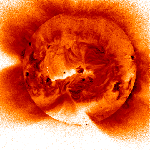 |
| Some
stars are much more violent than our Sun, displaying huge flares
which throw giant clouds of hot gas out into space. In the hottest
blue stars, the fierce radiation causes a stellar wind - very
thin hot gas from the star's surface - which streams into space
at thousands of kilometres per second. XMM will allow astronomers
to compare many different types of star by measuring changes
in their X-ray output and telling us more about the temperature
and motions of their X-ray emitting gas. |
|
X-ray bursts
Many stars occur in
pairs (binaries). There are several types of binary system which
emit X-rays. For example, this may occur when one of the stars
acts as a cannibal, feeding off its neighbour. If one of the
stars is a very small dense star - known as a white dwarf - gas
may be drawn from its companion into a spiralling disc before
crashing into the white dwarf at high speed. The temperature
of the gas in the disc may reach 100 million degrees Celsius.
|
|
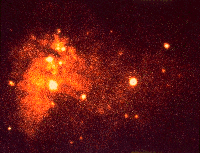
|
The
bright source on the centre left is the X-ray binary star system
LMC X-1 in the Large Magellanic Cloud, a satellite galaxy to
our own Milky Way |
|
When this build-up
of gas reaches a critical level on the white dwarf's surface,
an explosive nuclear reaction takes place. Each time this happens,
the dwarf star suddenly brightens, emitting huge amounts of both
X-rays and visible light, to become a 'nova'. After a few months
the star fades again.
Some X-ray binaries
are the strongest X-ray sources in our galaxy. They are formed
when gas from a nearby star is sucked towards an extremely dense
neutron star or black hole. Neutron stars are made almost entirely
of neutrons and may contain several times the mass of the Sun
within a diameter of about 20 km. Black holes are regions where
gravity is so strong that even light cannot escape.
In both cases, as the
inflowing gas is compressed, it becomes so hot that it radiates
X-rays, emitting thousands of times more energy than our Sun.
Sometimes, when gas builds up very quickly on the neutron star's
surface, a series of rapid nuclear explosions creates brief,
intense X-ray bursts every few seconds.
These may continue
for several days. XMM will tell us much more about such events
by studying the gas streaming from one star to another.
|
|
Supernovae
Extremely hot, massive
stars burn their supply of hydrogen and helium very quickly.
Once this fuel runs out, they collapse, causing a violent explosion.
These 'supernovae' release so much energy that they can outshine
entire galaxies. The explosions also eject hot shells of gas
at speeds reaching 20,000 km/s. X-rays are emitted by the gaseous
clouds while they remain hot, but they rapidly fade as the gas
cools. Since the cold gas gives out very little visible light,
the shells are difficult to detect with optical telescopes. The
only evidence for the existence of an old supernova remnant may
be a rapidly rotating neutron star (a pulsar), which may also
emit X-rays.
|
| |
This
coloured X-ray image shows the Vela supernova remnant which is
about 18,000 years old and lies 1300 light years away from Earth.
The colours represent X-ray intensity from blue (lowest) through
yellow and red to white (brightest) |
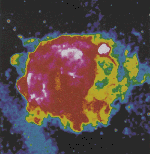 |
|
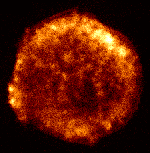 |
A
supernova remnant. The material seen here is travelling away
from the site of the supernova at 11,000 km/s |
|
| One of
the most famous examples lies at the heart of the Crab Nebula.
Here, electrons emitted by the pulsar energise the surrounding
nebula so that it emits X-rays. XMM will find similar supernova
remnants in our Milky Way and other nearby galaxies. |
|
The
Crab Nebula, a supernova remnant which is formed by gas ejected
during the supernova explosion and by interstellar gas which
has been swept up and ionised by the shock wave originating from
the explosion |
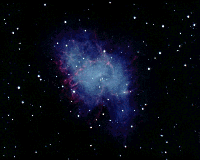 |
|
Beyond the
Milky Way
XMM will also probe
the most powerful X-ray sources of all - active galaxies and
quasars (very luminous, distant objects which look like stars
in telescopes) - which lie far beyond the Milky Way. These objects
give out huge amounts of radiation. In some cases this is due
to tremendous bursts of star formation ('starbursts') which produce
numerous supernova explosions and large clouds of hot gas.
X-rays may also occur
when a supermassive black hole in the centre of a galaxy generates
energy by swallowing nearby stars. These black holes may be millions
or billions of times more massive than the Sun. Any stars or
gas which get too close are trapped and destroyed. Enormous amounts
of X-rays are generated as glowing discs of gas swirl around
the black hole at speeds which may exceed 2 million km/h.
|
| |
| Evidence for a black hole at the core of galaxy
NGC 4261. This false-colour image was made by the Hubble Space
Telescope |
|
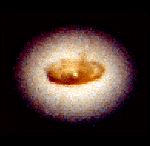 |
|
The X-ray
background
Whenever astronomers
look at the sky, they detect a faint background of X-ray radiation.
Some of this is emitted by hot, thin gas between galaxies. Although
this gas is extremely sparse, it covers such a vast area that
it may account for most of the atoms in the Universe. XMM will
allow us to study the gas and discover if this is true.
|
|
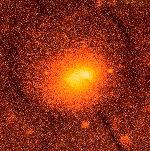 |
The
intensely hot gases between the galaxies in this cluster radiate
X-rays |
|
| Much
of the remaining X-ray background probably comes from swarms
of very young, active galaxies located in the far reaches of
the Universe. They are so far away that their X-ray radiation
has taken billions of years to reach us. Astronomers believe
the X-rays were generated during bursts of star formation as
the galaxies came together. XMM will test this theory by studying
X-ray sources near the edge of the observable Universe. |
|